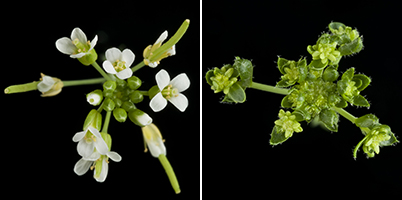They basically become zombies. And some bacterial parasites can even turn plants into the living dead.
A parasitic bacterium produces a protein called SAP54 that is essential to this process. The protein is dependent for its activity on a family of plant proteins called RAD23. It induces the plant to transform its flowers into leaf tissue, sacrificing its reproductive success and becoming sterile. It becomes a zombie plant – dead to the future and destined to benefit only the survival of the bacteria.
Scientists in the labs of Saskia Hogenhout from the John Innes Centre, and Professors Angenent and Immink at Wageningen University, have discovered these parasitic bacteria affect a broad range of plants, turning flowers green, transforming them into leaf tissue or producing a profusion of stems as in Witches Broom. They cause disease in crops including grapes, coconuts and oilseed rape.

Left: A healthy Arabidopsis flower. Right: Phytoplasma-infected Arabidopsis flower. Images: JIC
"For the first time, we can reveal how this remarkable manipulation takes place," says Hogenhout. "In that sense, the plant world is ahead of animal biology - where manipulations also take place but no mechanisms have been uncovered to show how.
"We know these parasites are puppet masters but the strings they are pulling have yet to be identified."
When leafhoppers eat infected plant material, the bacteria colonize the insects, including their salivary glands. If the insect dribbles saliva as it sucks on another plant, the bacteria are able to spread into new plant tissue. The bacteria set to work on making the plant more attractive to leafhoppers.
Via the SAP54 and RAD23 proteins, the plant is coerced into transforming its flowers into leaf-like material and becomes more attractive to leafhoppers for colonization. The leafhoppers pick up the bacteria from infected plants while feeding and then can spread the bacterial pathogen to yet more plants.
"This parasite is incapable of surviving without its insect and plant hosts and we showed that a parasite protein connects distinct processes in its host plant to manipulate both the plant and the insect vector," says Professor Hogenhout.
"It is fascinating to consider that this bacterium is able to manipulate the way plants grow and the way insects behave to suit its own needs," says JIC's Dr Allyson MacLean, first author of the paper.
The study sets the stage for understanding how other plant parasites, such as fungi, reprogram plant development. In another recent study, Hogenhout collaborated with scientists at The Sainsbury Laboratory to gain the first insights into how a fungal parasite is able to create pseudoflowers mimicking buttercups. Creating these flowers in a relative of broccoli from the mustard family helps attract insects that spread the spores of the fungus.
Citation: MacLean AM, Orlovskis Z, Kowitwanich K, Zdziarska AM, Angenent GC, et al. (2014) Phytoplasma Effector SAP54 Hijacks Plant Reproduction by Degrading MADS-box Proteins and Promotes Insect Colonization in a RAD23-Dependent Manner. PLoS Biol 12(4): e1001835. doi:10.1371/journal.pbio.1001835





Comments